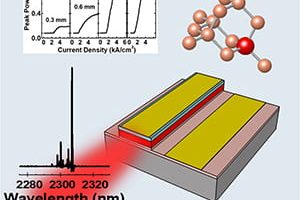The world’s fastest data transmission rate has been achieved by a team of UCL engineers who reached an internet speed a fifth faster than the previous record. Working with two companies, Xtera and KDDI Research, the research team led by Dr Lidia Galdino (UCL Electronic & Electrical Engineering), achieved a data transmission rate of 178Tbit/s – a speed at which ...
Research
The latest electronics research news from within the industry and universities from around the world.
Schottky junction turns a neutral crystal piezoelectric
Adding a Schottky junction to certain crystals can turn them into piezoelectric or pyroelectric crystals, even if they were unaffected by deformation or heat before, according to the the University of Warwick, where the research was done. The subjects were ‘centrosymmetric’ semiconductors. niobium-doped strontium titanium oxide crystals niobium-doped titanium dioxide crystals niobium-doped barium strontium titanium oxide (BSTO) ceramics silicon “Generally, ...
Laser-cut graphite sheet aids flow battery research
Flow batteries are energy storing structures that store chemical energy as liquid electrolytes in tanks, and pump those liquids to a reaction site – a membrane-electrode assembly (MEA) – when electricity must be produced or re-charge is needed. This separates the number of watts a flow battery can produce from the number of joules it can store – bigger tanks give ...
13 two-dimensional materials identified for FETs, some new
Swiss scientists have had a computational look at two-dimensional materials, like graphene, to see which will make the best transistors. From 100 candidate compounds, 13 show promise – in some cases more promise than the predicted trend of silicon finfets. The team, from ETH Zurich and EPFL (École Polytechnique Fédérale de Lausanne), modelled current versus voltage characteristics from first-principles on the Piz ...
Recycling: lemonade bottles into super-caps
A method of recycling plastic waste into a material for making supercapacitors has been developed by Scientists at UC Riverside. “Thirty percent of the global car fleet is expected to be electric by 2040, and high cost of raw battery materials is a challenge,” says Mihri Ozkan, UCR professor of electrical engineering, “using waste from landfill and up-cycling plastic bottles ...
Self-driving vehicle watches human to cope better in strange environments
Self-driving vehicles can learn from human drivers, then sometimes out-drive them, according to US Army research. The team designed an algorithm that allows an autonomous ground vehicle to improve its existing navigation systems by watching how a human driver remote-controlled the same vehicle, calling the approach ‘adaptive planner parameter learning from demonstration’ – APPLD. The approach was compared with current autonomous ...
Nanoparticle layer makes brighter LEDs
Researcher at Indian Institute of Technology (IIT) Guwahati have found a way to get more light out of LED die using nano-scale metal particles. This has nothing to do with making the particles into phosphors. Instead, is is a way of preventing light bouncing back into into a conventional LED die from the die-encapsulant boundary – a reflection that occurs ...
Monolithic laser on silicon is electrically-pumped
The University of Arkansas is claiming a first – an electrically-pumped germanium-tin laser grown monolithically on silicon. Electrical pumping is a big deal – many proof-of-concept semiconductor lasers, including an earlier version of this device, have to have their operating energy delivered optically through other lasers. However, the laser still requires cryogenic cooling to function. GeSn is of interest because ...
Prize winners recognised for unmanned underwater vehicle charging station
Northrop Grumman and Seatrec have been announced as winners of an Explorer Prize sponsored by the Department of Energy (DOE) and the National Oceanic & Atmospheric Administration (NOAA) in the United States. The competition sought to encourage innovative technology in marine renewable energy, to enable “more persistent and pervasive ocean observing”. The two companies together submitted the “Mission Unlimited UUV ...
Phone + 3D printer = easier soil measurement
Measuring the density of a random lump of soil sample is not as easy as you might think, according to New Mexico State University. Weighing it is simple – use a set of scales. But turning this weight into density requires the volume of a formless lump to be measured – you might need to know that the lumps soil ...
 Electronics Weekly Electronics Design & Components Tech News
Electronics Weekly Electronics Design & Components Tech News








